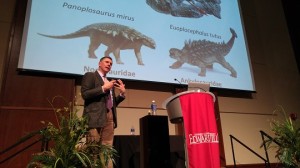Dino expert shares latest discoveries during annual Darwin Day celebration
Showcasing the latest in 3D modeling and technology, Dr. Lawrence Witmer, Professor of Paleontology in the Department of Biomedical Sciences at Ohio University presented the ways the advanced modeling techniques can further shed light on the large creatures that roamed the earth several millennia ago.

Dr. Lawrence Witmer, speaks about Dinosaurs during the Biological Sciences Departments annual Darwin Day presentation. (Photo by Joseph Lacdan)
“The physical interactive project is really seeking to try and understand how dinosaurs work. What nature has left us is the bones,” Witmer said. “We have to figure out how we can view those bones with biology. We need to reconstruct the soft tissues that used to be on those bones. And so we need to look at the modern day relatives of dinosaurs, birds and crocodilians, and lizards — animals that still have those soft tissues, still have physiology and then try to make those links between the soft tissues and physiology and the bone, then we can go check the dinosaur bone for the same features and try to reconstruct what these animals were like.”
Witmer’s featured presentation, “Fleshing Out Dinosaurs! From Darwin’s Bulldog to advanced 3D modeling,” highlighted the Biology Department’s annual Darwin Day celebration Feb. 12 at the Morris University Center.
Witmer said the 3D modeling began by analyzing the head and then incorporated the dinosaurs’ bodies. Witmer discussed new discoveries on dinosaurs, such as the predator Allosaurus, and how a new discovery of neck muscle made the meat eater similar to a Falcon. While the larger predator, Tyrannosaurus Rex, was more comparable to an alligator in its neck movements. He also presented current findings on the Stegosaurus, Diplodocus and the Majungasaurus.
Witmer also discussed how CT scanning and its X-ray technology allows closer examination of dinosaur bones than ever before. CT scanning can look through rock and allows paleontologists to study dinosaurs’ blood vessels. Researchers can also use the 3D modeling project to run new simulations and tests, such as running air through the nasal cavities of dinosaurs to simulate what type of sound it could make.
“I think students will learn how the technology can be used to answer complex questions,” said SIUE biology professor Chris Theodorakis. “As we get more technology there are questions that we couldn’t answer in the past. And basically learn the function of animals from looking at their structure.”
Witmer also fielded questions from an audience that ranged in age from elementary school students to retirees including the factors that contributed to the dinosaurs’ extinction. These factors included a multitude of events, such as massive lava flows in certain parts of the world and changes in sea levels and climactic weather patterns.
Witmer said the purpose of his presentation was also intended to generate interest in the sciences and encourage more students to pursue careers in scientific and biological fields.
“Hopefully that interest in science will carry over – and not necessarily turn people into scientists,” Witmer said. “But that people can be more literate about science because there’s so much in our world that requires everyone to know about science. The debates on climate change, vaccinations, evolution; these are all not matters of opinion, they are all matters of science. Anything we can do to promote people’s understanding of how science works is really important.”
Theodorakis said dinosaurs were an appealing topic to engage the public interest in science because of how the prehistoric creatures have captured the world’s imagination in popular culture and in films.
“They’re so different from things that are living today,” Theodorakis said. “They’re big, huge monsters … they’re kind of like mythological creatures almost.”
Filed Under: Biological Sciences












